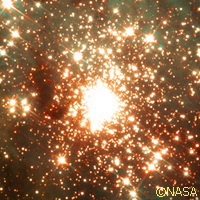Researchers investigate how nature helps to shape stars
German researchers have used state-of-the-art computer simulations to find the first evidence that the way in which stars form depends on their birth environment. Until now, it appeared that stars formed in the same manner everywhere. Stars are thought to form in interstellar space from dark clouds of gas and dust, and their properties are expected to depend on the conditions of their dusty birth environment, something this new study provides the evidence to support. Writing in the journal Monthly Notices of the Royal Astronomical Society, the team describes how they discovered that the mass distribution of stars does indeed depend on the environment in which they form. Leady study author, Dr Michael Marks from the University of Bonn, comments: 'Surprisingly, this evidence does not come to us from young regions of ongoing star formation, but from a very old class of objects, so called globular star clusters. The number of observed stars less massive than our Sun in globular clusters is at odds with their structure.' Globular clusters are massive congregations of thousands of stars surrounding the Milky Way; star formation in these clusters stopped billions of years ago. But using computer simulations, the team found that they could understand the connection between star formation and birth environment when invoking a process that occurs very early in the life of any cluster: residual gas expulsion. When a star has completed its formation, it starts to shine and eventually the radiation coming from the cluster of freshly-hatched stars quickly drives out the gas from which they formed. The region of star birth is then destroyed, leaving behind stars of different masses. Another study author, Pavel Kroupa, also from the University of Bonn, explains: 'This process leads to expansion of the whole aggregate of stars, with the accompanying stripping of some of the stars from the cluster by the gravitational attraction of the young Milky Way. The faster the gas is blown out, the stronger is the expansion and the more stars are removed. The imprint of this process is still visible in the present-day mass distribution.' This means that carefully observing present-day stellar populations in globular clusters allows their initial star content to be reconstructed. The astronomers' results show that globular clusters must have formed with many more massive stars than are counted in individual star-forming regions today. Dr Michael Marks adds: 'Otherwise, the star birth region a globular cluster formed from is not destroyed quickly enough and the subsequent expansion is too weak to remove enough stars from the cluster. If this had happened, the distribution of masses of stars we see today would be quite different.' According to the team's results, there only exist differences in the initial star content when conditions in the star birth regions are very extreme compared to those currently visible. These extreme environments are not seen today, but the team believe they may well have been frequent when globular clusters were born around 12 billion years ago. Pavel Kroupa comments: 'With this work, we might have uncovered the long-expected systematic differences in the star formation process.'For more information, please visit:Royal Astronomical Society (RAS):http://www.ras.org.uk/
Countries
Germany



